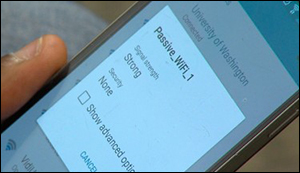UW engineers achieve Wi-Fi at 10,000 times lower power
24. 2. 2016 | University of Washington | www.washington.edu
A team of University of Washington computer scientists and electrical engineers has demonstrated that it’s possible to generate Wi-Fi transmissions using 10,000 times less power than conventional methods.
The new Passive Wi-Fi system also consumes 1,000 times less power than existing energy-efficient wireless communication platforms, such as Bluetooth Low Energy and Zigbee.
Passive Wi-Fi can for the first time transmit Wi-Fi signals at bit rates of up to 11 megabits per second that can be decoded on any of the billions of devices with Wi-Fi connectivity. These speeds are lower than the maximum Wi-Fi speeds but 11 times higher than Bluetooth.

Aside from saving battery life on today’s devices, wireless communication that uses almost no power will help enable an “Internet of Things” reality where household devices and wearable sensors can communicate using Wi-Fi without worrying about power.
An array of sensors produces Wi-Fi packets of information using very little power by simply reflecting and absorbing that signal using a digital switch. In real-world conditions on the UW campus, the team found the passive Wi-Fi sensors and a smartphone can communicate even at distances of 100 feet between them.
Read more at University of Washington
Image Credit: University of Washington
-jk-




